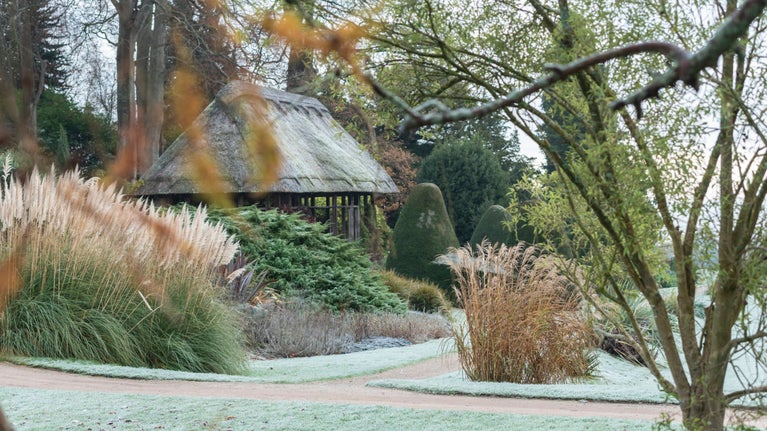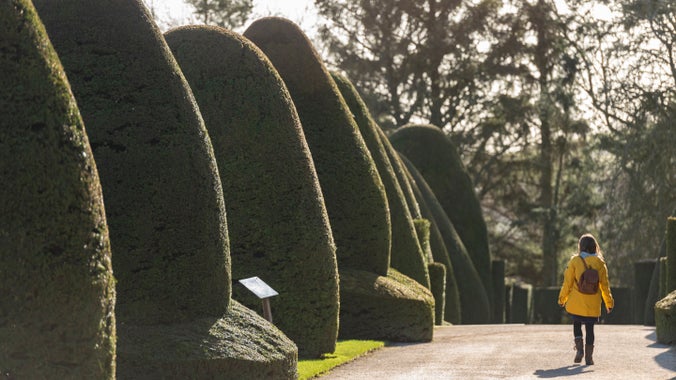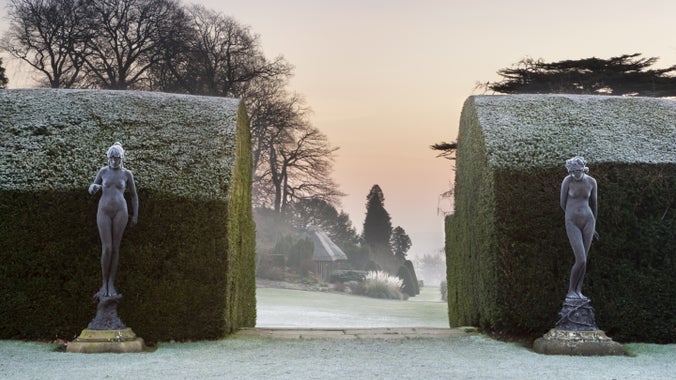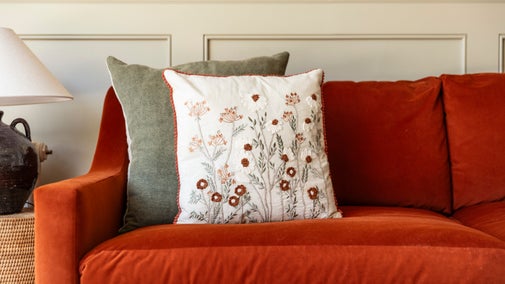
Discover more at Chirk Castle
Find out when Chirk Castle is open, how to get here, the things to see and do and more.

Indulge your senses and refresh your spirit with a gentle wander amongst the scents and seasonal colours of the rare shrubs and flowers in our lovely 5.5 acre garden.
Winter is a spectacular time to visit the garden at Chirk Castle.
Admire the freshly trimmed topiary with its crisp edges – it can look like a Christmas pudding in the snow or heavy frost and makes for a wonderful sight.
The long border is beautiful at this time of year, look out for the coloured stems of the Dogwoods, the white stems of the birches and the beautiful rockery, where the textures of different plants really stand out against the silver of the rocks.
Two acres of snowdrops create a dazzling, white carpet in the Pleasure Ground Wood in February. It’s a sight that can’t be missed. Meanwhile evergreen trees and topiary sparkle with frost on the coldest days and colourful dogwood stems brighten up the winter landscape.
Look out for clusters of yellow Mahonia flowers and spidery, fragrant flowers of hamamelis (witch hazel) blooming in red, orange and yellow, adding colour to the estate and garden.
The first formal garden was laid out by Sir Thomas Myddelton II in 1653, following contemporary French examples. The next major alterations were in 1764 when Richard Myddelton commissioned the landscape architect William Emes to remodel the gardens and parkland. Emes made substantial changes, moving fences, walls, pathways, and planting vast lawns and thousands of trees.
In the 19th century yew topiary, hedges and wrought iron gates were introduced, and then under the guidance of Lord Howard de Walden in the early twentieth century the celebrated gardener Norah Lindsay created a magnificent herbaceous border on the Upper Lawn.
The gardens were neglected during the Second World War until they were almost single-handedly revived by Lady Margaret Myddelton, creating the colourful planting scheme that our dedicated team of three full-time gardeners and garden volunteers maintain.

This curved border has three seasonal areas and is filled with shrubs and herbaceous plants. Lady Margaret Myddelton planted it after the Second World War as a low-maintenance way to ensure seasonal colour and scent.
Built in 1854 to an E.W. Pugin design and there used to be an 18th-century orangery on the same site. Originally a conservatory, Lord Howard de Walden added a thatched roof, to house birds of prey.
Late spring rhododendrons smell wonderful after a spring shower and an early summer highlight is the handkerchief tree with its elegant white bracts. In the autumn you can see rich toasty colours throughout.
During his 18th-century work on the parkland, William Emes added several 'ha-ha' to provide unobstructed views of the sweeping parkland and fields beyond, whilst keeping the parkland animals out. There are great views from the ha-ha at the bottom of the garden.
Lady Margaret Myddelton was very fond of roses - especially scented ones. Many of her favourite varieties included Dearest (soft pink), Allgold (bright golden colour) and Elizabeth of Glamis (salmon pink).
We have many roses around the garden from tall climbers like Rosa ‘Madame D’Arblay with soft pink carnation-like flowers, to Rosa ‘Blanc Double de Coubert’ - a white shrubby variety, as well as Rosa ’Golden Celebration’ and Rosa ‘Jubilee Celebration’.
This formal area of woodland is right next to the main garden and is bisected by pathways arranged to provide easy and peaceful walking routes. In February there is an incredible display of snowdrops, followed in turn by bluebells and foxgloves.
A small Kitchen garden is slowly being developed behind the Squash Court near Home Farm, here we have a small orchard and vegetable plots with a range of vegetables in season that are sold through the retail shop.

We plant everything from large shrubs to the smallest rockery at Chirk Castle. Look out for some seasonal plants across the seasons.
From large shrubs to the smallest rockery plant of a few inches tall, rhododendrons give a regular display with all the colours of the rainbow. We have the larger varieties ‘arboreum’ and many hardy hybrids in the Wild Garden and Shrub Garden.
A different type of rhododendron. We have mainly deciduous types with scented flowers in whites, oranges and pinks and Japanese evergreen types on the rockery with primarily pink flowers.
From the tiny Narcissus cyclamineus to the large-flowered Narcissus King Alfred. Spot them in the lime avenue and long border areas.
Lady Magaret Myddelton was very fond of the iris. She liked mainly blue forms and these are prominent on the Long Border. You can see a number of varieties including Iris siberica and the small Iris innominata in the Shrub Garden, and Iris stylosa, the winter flowering species on the Long Border.
Angel’s Fishing Rods or Wand Flower are a prominent feature of the garden from July to September. The bells vary in colour from pale pink to purple and arch above grass-like foliage.
We have numerous varieties all with their broad leaves throughout the summer. To the envy of our visitors, our gritty loam tends to discourage slugs so ours remain hole free.
Here are the most striking varieties to look out for: A. September Charm, A. Whirlygig - double white form, A. Konigin Charlotte - semi double pink and A. Honorine Jobert - glowing single white.

Find out when Chirk Castle is open, how to get here, the things to see and do and more.
Take a walk around Chirk's fascinating 480-acre parkland, and discover a working landscape full of ancient trees, wild flowers, birds and bugs.

Chirk Castle was never planned as a family home. It was one of several medieval Marcher fortresses along the Welsh-English border, built to keep the Welsh under English rule.

The 480-acre estate can be a great place to explore with your pooch whatever the weather. Find out more about where you can take your dog and where you can stop for a tasty treat.

Visit our tea-room and enjoy homemade cakes that are baked daily, using the freshest ingredients. Or visit the gift shop which is packed with handmade treats and souvenirs.

Chirk Castle was never planned as a family home. It was one of several medieval Marcher fortresses along the Welsh-English border, built to keep the Welsh under English rule.
